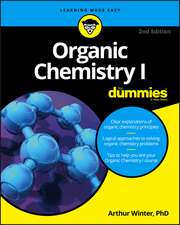Organotitanium Reagents in Organic Synthesis: Reactivity and Structure: Concepts in Organic Chemistry, cartea 24
Autor Manfred T. Reetzen Limba Engleză Paperback – 17 noi 2011
Din seria Reactivity and Structure: Concepts in Organic Chemistry
- 15%
 Preț: 637.93 lei
Preț: 637.93 lei - 15%
 Preț: 638.57 lei
Preț: 638.57 lei -
 Preț: 402.76 lei
Preț: 402.76 lei -
 Preț: 388.13 lei
Preț: 388.13 lei - 15%
 Preț: 650.19 lei
Preț: 650.19 lei -
 Preț: 400.65 lei
Preț: 400.65 lei - 18%
 Preț: 721.63 lei
Preț: 721.63 lei -
 Preț: 378.71 lei
Preț: 378.71 lei -
 Preț: 378.71 lei
Preț: 378.71 lei - 15%
 Preț: 641.53 lei
Preț: 641.53 lei -
 Preț: 380.84 lei
Preț: 380.84 lei - 15%
 Preț: 636.45 lei
Preț: 636.45 lei - 15%
 Preț: 650.37 lei
Preț: 650.37 lei - 15%
 Preț: 640.08 lei
Preț: 640.08 lei - 15%
 Preț: 640.06 lei
Preț: 640.06 lei -
 Preț: 387.20 lei
Preț: 387.20 lei -
 Preț: 380.84 lei
Preț: 380.84 lei - 15%
 Preț: 639.08 lei
Preț: 639.08 lei - 15%
 Preț: 639.08 lei
Preț: 639.08 lei -
 Preț: 381.81 lei
Preț: 381.81 lei -
 Preț: 382.57 lei
Preț: 382.57 lei -
 Preț: 395.25 lei
Preț: 395.25 lei - 15%
 Preț: 642.83 lei
Preț: 642.83 lei - 15%
 Preț: 643.34 lei
Preț: 643.34 lei -
 Preț: 378.54 lei
Preț: 378.54 lei - 15%
 Preț: 636.45 lei
Preț: 636.45 lei - 20%
 Preț: 546.17 lei
Preț: 546.17 lei - 15%
 Preț: 638.43 lei
Preț: 638.43 lei
Preț: 387.75 lei
Nou
Puncte Express: 582
Preț estimativ în valută:
74.20€ • 77.82$ • 61.77£
74.20€ • 77.82$ • 61.77£
Carte tipărită la comandă
Livrare economică 01-15 aprilie
Preluare comenzi: 021 569.72.76
Specificații
ISBN-13: 9783642707063
ISBN-10: 3642707068
Pagini: 252
Ilustrații: X, 236 p.
Dimensiuni: 170 x 244 x 13 mm
Greutate: 0.41 kg
Ediția:1986
Editura: Springer Berlin, Heidelberg
Colecția Springer
Seria Reactivity and Structure: Concepts in Organic Chemistry
Locul publicării:Berlin, Heidelberg, Germany
ISBN-10: 3642707068
Pagini: 252
Ilustrații: X, 236 p.
Dimensiuni: 170 x 244 x 13 mm
Greutate: 0.41 kg
Ediția:1986
Editura: Springer Berlin, Heidelberg
Colecția Springer
Seria Reactivity and Structure: Concepts in Organic Chemistry
Locul publicării:Berlin, Heidelberg, Germany
Public țintă
ResearchCuprins
1. Introduction.- 1.1 Adjustment of Carbanion-Selectivity via Titanation.- 1.2 Other Uses of Titanium in Organic Chemistry.- References.- 2. Synthesis and Properties of Some Simple Organotitanium Compounds.- 2.1 Synthesis and Stability.- 2.2 Bond Energies.- 2.3 Bond Angles and Lengths.- 2.4 Aggregation State.- 2.5 Spectroscopic and Theoretical Aspects.- 2.6 Conclusions.- References.- 3. Chemoseleetivity in Reactions of Organotitanium Reagents with Carbonyl Compounds.- 3.1 Aldehyde/Ketone Differentiation.- 3.2 Aldehyde/Aldehyde and Ketone/Ketone Differentiation.- 3.3 Chemo- and Regioselective Additions to ?,?-Unsaturated Carbonyl Compounds.- 3.4 Aldehyde/Ester and Ketone/Ester Differentiation.- 3.5 Reactions in the Presence of Additional Functionality.- 3.6 Addition to Enolizable Ketones.- 3.7 Limitations of Organotitanium Reagents.- 3.8 Hints on How to Use Organotitanium Compounds.- 3.9 Why Does Titanation of Carbanions Increase Chemoselectivity?.- 3.10 Comparison with Other Organometallic Reagents.- 3.11 Reversal of Chemoselectivity: Chemoselective in situ Protection of Carbonyl Compounds.- 3.12 Organotitanium Reagents from Non-Organometallic Precursors 107 References.- References.- 4. Rates of Reactions.- 4.1 Kinetics of the Addition of CH3Ti(OCHMe2)3 to Carbonyl Compounds.- 4.2 Other Kinetic Studies.- References.- 5. Stereoselectivity in the Addition of Organotitanium Reagents to Carbonyl Compounds.- 5.1 Titanation of Carbanions as a Means to Control Stereoselectivity.- 5.2 Diastereofacial Selectivity.- 5.3 Simple Diastereoselectivity.- 5.4 The Problem of Equatorial vs. Axial Addition to Cyclic Ketones.- 5.5 Enantioselective Additions.- References.- 6. Michael Additions.- References.- 7. Substitution Reactions.- 7.1 Titanium Enolates as Nucleophiles.- 7.2Alkyltitanium Compounds as Nucleophiles.- 7.3 Other Substitution Reactions: Present and Future.- References.- 8. Wittig-type Methylenation of Carbonyl Compounds.- References.







